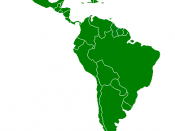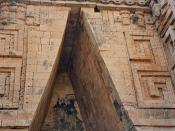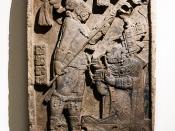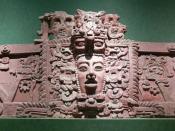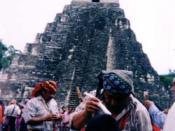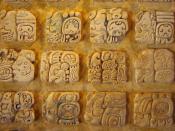What is culture? Who are the Mayas and what problems do they face today? In the text below these questions and concerns will be explored and articulated in greater depth regarding Mayan communities and their freedoms in Latin America.
Culture is an ideology of language, beliefs, and social organization. Culture is energetic, despite the fact that it is constantly evolving. However, it is this continuous evolution culture that tends to keep the essential sameness. This sameness is what people identify with and hold true for themselves and their families.
The Mayan culture began five thousand years ago in what is now: Southern Mexico, Honduras, El Salvador, Belize, and Guatemala. The Maya founded ideas pertaining to the number zero mathematically, five hundred years before inhabitants of India. Mayan astronomers are said to have constructed the most precise calendar in existence prior to the introduction of modern astronomy. The Maya domesticated corn, rubber, and chocolate.
Furthering their studies in holistic medicines, mathematics, architecture, and astronomy.
Mayan culture has been growing around the just and unjust circumstances that the Maya have endured for generations upon generations. Although it still remains nearly the same culture that was developed thousands of years ago. The original form of their culture has changed but the essence remains the same.
Mayan shamanism plays a key role in Mayan culture. The Maya believe that there is a spiritual contract between the living and the Gods. Mayans thought that If remembrance were lost then life and this world would cease as confirmed by Prechtel: "This world can only continue as long as the living payhomage to the gods. The gods gave man life and this world on a basis that man would not neglect to perform sacred rituals in the god's honor, for gods seek remembrance"ÃÂ (Prechtel pg57).
Shamans have no special uniform, they practice either alone or with an apprentice. Shamans perform rituals in private or at special mountains hrines that are well secluded. Shamans are said to be frail and frightened.
They were not "blessed"ÃÂ with human spiritual amnesia. They remember and see the worlds they previously inhabited in snippets. Mayans are "scared"ÃÂ of their previous lives or their previous selves, instead of the world they currently inhabit. This world is said to be far too rigid, scary, and sharp for a shaman's soul to bear. To become a Mayan Shaman is a birthright, to be a Shaman is not a social position one would seek. The positions parents most wanted for their children included: farmers, canoe carvers,and people of great strength. Being able to carry heavy loads was of prestige status. The strength a man had could determine social status. When a child was born and they appeared "dazed"ÃÂ and "distant"ÃÂ wordwould get around, sometimes these children would become sickened by "visions."ÃÂ A shaman would be sent for and if symptoms were correct then the Shaman would take the young one under his/her wing and when the time was right the young one would begin his/her training. Shamans taught each other how to learn and remember. Then older Shaman would give suggestions on how to use the memories obtained from the unconscious. Shamans are summoned to fight oblivion and evil they are witch doctors. Shamans are connected with all things spiritual and supernatural. Shamans have connections with the spiritual world that most do not. A Shaman "baby"ÃÂ appears in a family bloodline each two, to four generations. Shamans never speak of their rituals and practices, Shamans do not even call themselves Shamans, common folk do behind the shaman's back.
Most of these beliefs and practices are disregarded by the Ladino (mixed blood of Spaniards and Maya) population in lower Latin America (mixed blood of Spaniards and Maya). Ladino governments constantly pursue policies that force the Maya "to give up their primitive culture for a more civilized European life, the hope that will lead to a more economic integration and growth"ÃÂ(Otzoy, Colop, Raxche pg 52). As a whole Latin America faces much segregation and discrimination, currently there are few political movements that seek change in a society that walks upon their indigenous counterparts rather than celebrating their roots as a culture. Culturally and historically the Maya have been denied a voice in telling their story. According to Fabian, much of the political agendas Maya political activists hold, are those of regaining at least partial control over academic and popular portrayals of themselves, "Westerners' attempts at empowerment of indigenous peoples often appearto be old colonialism in new disguise (Fabian pg 3)."ÃÂ The Maya of Guatemala are using their ethnicity as a tool to offset meddling by neocolonial organizations. Mayan activists are hoping to raise Maya languages to co-official status; they also propose a unified alphabet. Many Ladino's criticize Maya languages as being "defective,"ÃÂ or "incomplete."ÃÂ There are many loan words that are from Spanish origin. Mayan activists raise the awareness that these loan words are the result of a cross linguistic contact that is in most languages.
For example "Spanglish."ÃÂ There are many loan words that are English but derived from Spanish: mosquito, rodeo, guerilla, and chili. In Guatemala the countries Maya population contains twenty-one languages from twenty-one separate language groups. Out of ten million inhabitants between 50% and 60% are Mayan. Many Mayans have opted to become Ladino in the hope to avoid discrimination and to increase racial integration into national educational systems and local commercial networks that are controlled by the Ladino population. It is hard for a Maya to "make it,"ÃÂ while living in his/her home community. Therefore, many Maya leave their homes to large cities in the hope of not being recognized as being "indigenous"ÃÂ. The unequal distribution of wealth in Guatemala has instilled a fear in the Ladino hearts. Ladinos fear an indigenous uprising. With this the government has tried to integrate the indigenous communities as a social underclass rather than a modern nation state as opposed to a separate ethnic group with its own political agenda. The Pan-Maya Movement works for the conservation and resurrection of Maya culture while advocating governmental reform in the current Guatemalan constitution. The current Guatemalan constitution recognizes people of Maya descent as ethnic minorities; it does not fully acknowledge ethnic communities as subjects with rights. The Maya have many compensational demands: territorial, political reformation, jurisdictual reform, development of indigenous languages in education and mass media, restructuring of education and many more. The Maya seek land compensation ranging back to 1821 when Independence was won from Spain.
Territories have been expropriated and must be returned as stated in the ensuing quote: "The Maya land is not merely an object of possession and means of production rather an important element in their beliefs, customs, and culture"ÃÂ(Cuxil pg 31). The Maya feel that the soil and sub-soil belong to the indigenous and that what happens with natural resources should be checked with indigenous communities.
Currently the Maya have no voice in petroleum and minerals markets. Maya political demands ask for representation in congress allowing legislators to defend indigenous interest. Maya representation should mirror the numerical density of each indigenous community. Maya's opinion in Ladino politics has always been disregarded with ridicule. The Mayan communities feel that any and all acts regarding Mayan interest should be carried out with participation of Maya representatives who hope to better conditions for the indigenous. Up to only a few years ago Ladino bureaucrats came up with policies for the indigenous without any consideration for the Maya people. Mayans feel that Maya citizens should be appointed as public functionaries of the state. This would allow the Maya to deal with official political matters in their own languages rather than struggling with a foreign language. Right now functionaries who represent Mayan matters do not speak the languages of the Mayan population and they have no intention of ever learning them. Discrimination denies the Maya fundamental human rights and freedoms enjoyed by the Ladinos. The Maya feel that the use of their languages should be taught to their children in school beginning at an elementary level. At the moment schools neglect to teach Maya languages producing "Hispanicized Indians and not Mayan Spanish bilinguals (Cuxil pg 37)."ÃÂ This calls for a restructuring of proper schooling Maya students should be taught everything their ethnic communities have to offer. Teaching children cultural awareness supports identity while protecting children from cultural alienation. The current education system denies the Maya children knowledge of their own history. The culture the Mayan children are taught is in the Ladino perspective. Ladinos exploitation of Mayan culture to tourists only goes to show the moral cynicism of the Ladinos. The Maya want to organize their own cultural institutions. At the moment Ladinos regulate pop culture, media, plus they own all universities and schools.
In conclusion, I have only touched upon a very few items concerning racial indifference or racial discrimination there still remains greater depth to be studied, learned and shared. Indigenous discrimination stems from a long line, a very long history of domination by colonist, by imperialist.
Indeed, one of the major problems Mayans face today is Discrimination! A serious social problem that entails political, judicial, and cultural exceptions and restrictions that in turn limit the Mayan Indians the ability to exercise freely as human beings with basic human rights in their daily existence.
